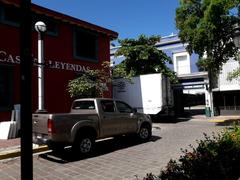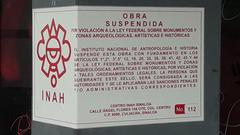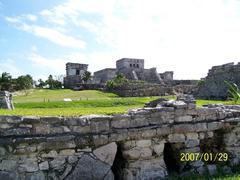
Instituto Nacional de Antropología e Historia (INAH) Tulum: Visiting Hours, Tickets, and Travel Guide
Date: 14/06/2025
Introduction
Nestled along the Caribbean coastline of Mexico’s Yucatán Peninsula, the Instituto Nacional de Antropología e Historia (INAH) site in Tulum offers an unparalleled window into the region’s cultural and natural legacy. Renowned for its dramatic Mayan ruins perched atop cliffs above turquoise waters, Tulum represents more than history—it is a living intersection of ancient civilization, ecological conservation, and contemporary culture. Managed by INAH, Mexico’s foremost institution for safeguarding archaeological and historical treasures since 1939, the Tulum site embodies centuries of Maya achievements alongside modern conservation and educational initiatives (INAH Official Guide; Tulum Times).
Visitors to Tulum can immerse themselves in well-preserved ruins such as El Castillo, the Temple of the Frescoes, and the Temple of the Descending God. These are complemented by interactive experiences at the Museo Regional de la Costa Oriental (Mureco) and ecological adventures in the expansive Parque del Jaguar. This newly established park preserves native wildlife, including jaguars, and features eco-friendly infrastructure, scenic trails, and integrated access to beaches—all contributing to a sustainable tourism model in harmony with the archaeological zone (The Cancun Sun; Infobae).
This detailed guide compiles official updates, historical context, and practical tips to help travelers fully appreciate Tulum as both a treasured archaeological landmark and a vibrant cultural landscape. Whether you’re a history buff, nature lover, or casual visitor, Tulum’s blend of ancient marvels and modern conservation initiatives promises a uniquely enriching experience.
Table of Contents
- About INAH: Guardians of Mexico’s Past
- Visiting INAH Museums and Sites
- Spotlight on Tulum: A Must-See Archaeological Site
- Parque del Jaguar and Museo Regional de la Costa Oriental
- Tulum Archaeological Zone: Hours, Tickets & Visitor Guide
- Summary and Final Tips
- References and Further Reading
About INAH: Guardians of Mexico’s Past
Founded in 1939, INAH is Mexico’s primary authority on archaeology, history, and cultural preservation. Overseeing more than 160 museums and hundreds of archaeological sites—including the iconic Tulum ruins—INAH not only conserves these treasures but also leads educational programs, research, and community outreach to ensure Mexico’s heritage endures (INAH Official Guide).
Visiting INAH Museums and Sites
Opening Hours
Most INAH museums and archaeological sites, including Tulum, are open from 9:00 AM to 5:00 PM. However, hours can vary on holidays or special event days—confirm details on the official INAH website or by contacting the site directly.
Tickets and Admission Fees
- National Museum of Anthropology (Mexico City): ~85 MXN for adults; free for residents on Sundays.
- Tulum Archaeological Site: ~80–100 MXN for adults; discounts for students and seniors. Tickets are available at entrances or through official online channels. Guided tours may include ticket costs.
Guided Tours and Accessibility
Guided tours are widely available, providing historical context and deeper insights. Most sites offer accommodations for visitors with limited mobility, but it’s best to confirm accessibility options in advance.
How to Access INAH Sites
- Tulum: Easily reached by car, taxi, bus, or bike from Tulum town, Playa del Carmen, or Cancun. Parking is available near the entrance.
- National Museum of Anthropology: Located in Chapultepec Park, Mexico City, accessible by metro, bus, or taxi.
Visitor Tips
- Visit early to avoid crowds and midday heat.
- Wear comfortable shoes; bring water, sunscreen, and a hat.
- Follow site rules to help preserve Mexico’s cultural patrimony.
Spotlight on Tulum: A Must-See Archaeological Site
Historical Development of Tulum
Pre-Columbian Origins and Early Settlement
Evidence suggests the Tulum region has been inhabited for over 10,000 years, with early Maya settlements emerging around the Postclassic period (~1200–1520 CE). The city, originally called Zama or “City of Dawn,” was strategically built on a cliff to monitor sunrise and maritime activity (Discover Magazine; Tulum Times).
Rise as a Trade and Religious Center
During the 13th to 15th centuries, Tulum flourished as a major port and trade center. Goods such as jade, obsidian, salt, and cacao were exchanged here, reflected in the city’s massive defensive walls and elaborate temples adorned with murals and carvings (Tulum Times).
Architectural Features and Urban Layout
The city is enclosed on three sides by limestone walls, with the sea forming the fourth barrier. Landmark structures include:
- El Castillo: A cliff-top building serving as a lighthouse and watchtower.
- Temple of the Frescoes: Noted for murals and use as an observatory.
- Temple of the Descending God: Distinguished by its unique deity carving. Urban planning reflects Mayan cosmological principles (Tulum Times).
Spanish Contact and Abandonment
Tulum was still occupied when the Spanish arrived in 1518. European diseases and conflict led to its decline by the late 16th century, though Maya communities continued to use the site ceremonially (Discover Magazine; Tulum Times).
Rediscovery and Archaeological Exploration
Tulum drew international attention in the 19th century with explorers like Stephens and Catherwood. Systematic archaeological work began in the 20th century under INAH (INAH Mediateca).
Cultural Significance
Symbol of Mayan Resilience and Innovation
Tulum’s walls, temples, and astronomical alignments showcase Maya ingenuity and adaptability in the face of change (Discover Magazine).
Spiritual and Ceremonial Importance
Temples and murals reveal Maya spiritual beliefs and continued ceremonial use by local communities long after abandonment (Tulum Times).
Modern Role in Mexican Heritage
Tulum is a symbol of Indigenous heritage, and its preservation by INAH highlights the importance of celebrating pre-Hispanic history (INAH Mediateca).
Contemporary Tourism and Sustainability
As a top destination, Tulum inspires eco-friendly resorts and responsible tourism practices (Tulum Times).
Conservation Challenges and Research
INAH restricts access to sensitive areas and encourages sustainable visitation. Ongoing research continues to reveal new aspects of Tulum’s history (Discover Magazine).
Visitor Information
Visiting Hours
- Tulum Ruins: 8:00 AM–5:00 PM daily (last entry 3:30 PM).
- Best Time: Early morning or late afternoon to avoid crowds and heat.
Ticket Prices and Where to Buy
- Tulum Archaeological Zone: 100 MXN (general admission); discounts for students, seniors, and children.
- Parque del Jaguar: 415 MXN (foreigners), 255 MXN (nationals), 105 MXN (Quintana Roo residents), 31 MXN (teachers/students with valid ID).
- Mureco Museum: 150 MXN (adults); discounts available. Purchase tickets at official counters; avoid unauthorized resellers (Infobae; CDMX Secreta).
Accessibility
- Main pathways are paved and suitable for wheelchairs and strollers.
- Some structures feature uneven terrain or steps.
- Restrooms and shaded areas are available.
How to Get There
- Located 2 km from Tulum town; accessible by taxi, bike, car, shuttle, or public transport from Playa del Carmen or Cancún.
Nearby Attractions
- Cenotes (Gran Cenote), Sian Ka’an Biosphere Reserve, local beaches, and vibrant Tulum town center.
Guided Tours and Events
- Certified guides are available at the entrance.
- Seasonal events and cultural ceremonies occur throughout the year.
Photography
- Photography is allowed, but drones require special permission.
Discover Parque del Jaguar and Museo Regional de la Costa Oriental: Your Complete Guide to Visiting Hours, Tickets, and Tulum Historical Sites
Parque del Jaguar
- Overview: Opened in 2023–2025, spanning 2,900+ hectares, incorporating Tulum National Park, and protecting endangered jaguars (The Cancun Sun; InMexico).
- Hours: 8:00 AM–6:00 PM daily.
- Tickets: ~250 MXN for adults; discounts for children, seniors, and locals.
- Activities: Hiking, biking, cenote swimming, wildlife observation, electric train rides, and panoramic viewpoints.
- Accessibility: Wheelchair-friendly paths and facilities.
- Sustainability: Car traffic is rerouted; eco-friendly infrastructure and electric trains reduce environmental impact (InMexico).
Museo Regional de la Costa Oriental (Mureco)
- Location: Inside Parque del Jaguar, near the archaeological zone (Tulum Times).
- Hours: 9:00 AM–5:00 PM (Tuesday–Sunday).
- Tickets: 150 MXN (adults); discounts for children, students, and seniors.
- Highlights: 300+ original artifacts, interactive technology, immersive storytelling, accessible facilities, and community educational programs (Your Tulum Concierge).
- Travel Tip: Combine your museum visit with the ruins and park for a full-day experience.
Synergy Between Sites
These sites are designed for seamless exploration, allowing visitors to experience Maya history and Tulum’s natural environment in one journey (InMexico; Tulum Times).
Tulum Archaeological Zone: Visiting Hours, Tickets & Visitor Guide to Tulum Historical Sites
Site Layout and Main Attractions
- El Castillo, Temple of the Frescoes, Temple of the Descending God—all accessible via well-maintained trails.
- Museo Regional de la Costa Oriental (Mureco): Artifacts and interpretive exhibits.
- Parque del Jaguar: Birdwatching towers, scenic lookouts, and access to beaches.
Visiting Hours and Access
- Tulum Ruins: 8:00–17:00 (last entry 15:30)
- Mureco Museum: 9:00–17:00 (closed Mondays)
- Parque del Jaguar: 8:00–19:00 (last entry 17:00) (Infobae)
Tickets and Fees
- Archaeological Zone: 100 MXN (general), with exemptions for certain groups.
- Parque del Jaguar: 415 MXN (foreigners), 255 MXN (nationals), 105 MXN (residents), 31 MXN (students/teachers).
- Sunday Free Admission: For Mexican citizens and residents (INAH sites only; park fees still apply) (CDMX Secreta).
Visitor Flow, Accessibility, Facilities
- Arrive early to avoid crowds.
- Paved, accessible pathways throughout.
- Amenities: restrooms, shaded rest areas, food vendors, souvenir shops, and interpretive signage.
Safety, Conservation, and Sustainable Tourism
- No climbing on ruins.
- No drones without permission.
- Stay on designated paths; respect wildlife.
- Electric vehicles and bike paths minimize environmental impact.
- Educational campaigns promote responsible tourism.
Practical Tips
- Bring sun protection and water.
- Buy tickets only at official counters.
- Bring ID for discounts.
- Photography allowed; tripods may require permits.
Getting There
- Easily accessed from Tulum town by car, taxi, bike, or public transport.
- Parking available (fills quickly during peak times).
- Shuttle services offered by local operators.
Special Considerations
- Free admission on Sundays for Mexican citizens/residents (expect crowds).
- Residents of Tulum municipality can access Parque del Jaguar for free with valid ID.
FAQs
- Hours: 8:00–17:00 (last entry 15:30)
- Tickets: 100 MXN (archaeological zone), variable park/museum fees.
- Guided Tours: Available at entrance.
- Accessibility: Main paths wheelchair and stroller-friendly.
- Swimming: Permitted at adjacent beaches, not directly at cliffside ruins.
- Photography: Allowed; drones require permission.
Summary and Final Tips for Visiting INAH Tulum
A visit to INAH Tulum is a journey through time and nature, highlighting the Maya civilization’s enduring legacy and the region’s ecological treasures. The archaeological zone’s stunning ruins, the immersive Museo Regional de la Costa Oriental, and the expansive Parque del Jaguar together create a comprehensive visitor experience that balances education, culture, and environmental stewardship (INAH Official Guide; Tulum Times; The Cancun Sun).
Plan your visit around official hours, purchase tickets from authorized sources, and take advantage of guided tours and educational programs. Sustainable tourism initiatives—like electric transportation and eco-friendly infrastructure—underscore INAH’s commitment to preserving Tulum’s heritage (Infobae; CDMX Secreta).
For up-to-date information, guided audio tours, and interactive maps, download the Audiala app and follow INAH’s official channels. Experience the profound history, vibrant culture, and breathtaking landscapes that define Tulum.
References and Further Reading on INAH Tulum and Related Historical Sites
- Visiting INAH Museums and Mexican Heritage Sites: Hours, Tickets & Visitor’s Guide, 2025, INAH (INAH Official Guide)
- Tulum Ruins: Visiting Hours, Tickets & Historical Guide to Quintana Roo’s Iconic Mayan Site, 2025, Tulum Times (Tulum Times)
- Parque del Jaguar and Museo Regional de la Costa Oriental: Visiting Hours, Tickets, and Tulum Historical Sites Guide, 2025, The Cancun Sun, InMexico, Tulum Times (The Cancun Sun), (InMexico), (Tulum Times)
- Tulum Archaeological Zone Visiting Hours, Tickets & Visitor Guide, 2025, Infobae, CDMX Secreta (Infobae), (CDMX Secreta)














